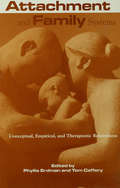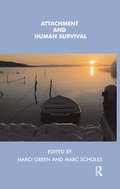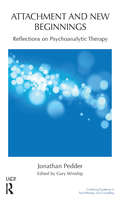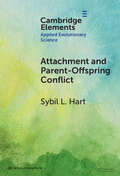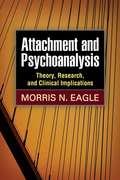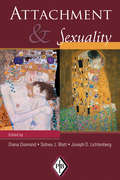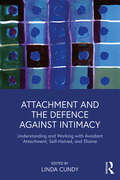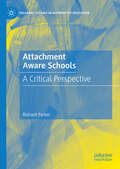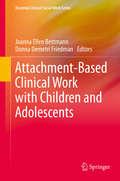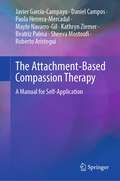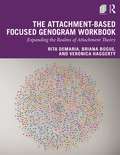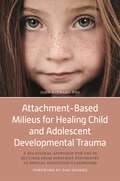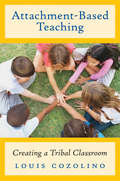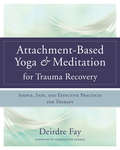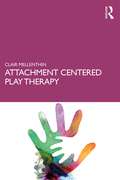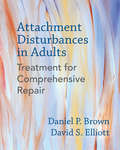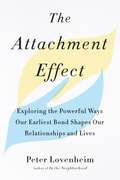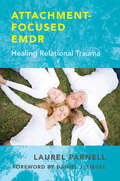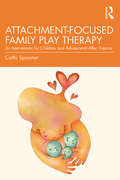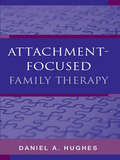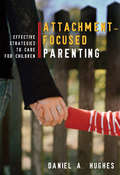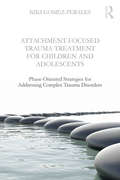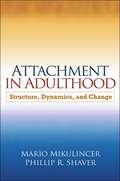- Table View
- List View
Attachment and Family Systems: Conceptual, Empirical and Therapeutic Relatedness (Routledge Series on Family Therapy and Counseling)
by Phyllis Erdman Tom CafferyIAttachment and Family Systems is a cogent and compelling text addressing the undeniable overlap between two systems of thought that deal with the nature of interpersonal relationships and how these impact functioning. In this enlightening work, leading thinkers in the field apply attachment theory within a systemic framework to a variety of life cycle transitional tasks and clinical issues.
Attachment and Human Survival
by Marci Green Marc ScholesWhat is it about childhood experiences that influence the kind of adult we become? For John Bowlby and others who developed Attachment theory, much of the answer lies in the quality of early attachments to our primary caregivers. When those attachments are secure, we can develop a safe sense of self. When insecure, we may go on seeking safety throughout our lives, in inappropriate and painful ways. Attachment, argued Bowlby, is a matter for individual and species survival.Using principles pioneered by Bowlby, this volume explores the importance of attachments to individuals and communities. Drawing on the work of leading figures in the field of Attachment research and clinical practice, this book introduces readers to the basic ideas and applications of Attachment theory. Chapters explore, for example, the role of attachment experience in brain development, the cultural and institutional contexts in which attachment systems operate, the political consequences of personal suffering and the uses of Attachment theory in psychotherapy.
Attachment and New Beginnings: Reflections on Psychoanalytic Therapy (The\united Kingdom Council For Psychotherapy Ser.)
by Jonathan PedderThis collection of written pieces plots the work of an NHS psychotherapist, Jonathan Pedder, turning the science of psychiatry into human encounters. He had a career teaching and inspiring colleagues and students with psychoanalytic ways of thinking, encouraging and supporting them in the challenges of contemporary psychiatry. In his work he made the world of psychoanalysis accessible to non-analysts, and this book augments the textbook on psychotherapy which Pedder wrote with Dennis Brown. Pedder was a quiet visionary influential in offering a pathway for mental health workers from many disciplines to find their way to the psychoanalytic ideas that illuminate their patients/clients.'- Professor R. D. Hinshelwood, Author of Clinical Klein and Dictionary of Kleinian Thought.
Attachment and Parent-Offspring Conflict: Origins in Ancestral Contexts of Breastfeeding and Multiple Caregiving (Elements in Applied Evolutionary Science)
by null Sybil L. HartThis Element builds on the mainstream theory of attachment and contemporary understanding of the environment of evolutionary adaptedness to address the origin and nature of infant-maternal bond formation. Sections 2 and 3 propose that attachment behaviors for protesting against separation and usurpation were compelled by infants' needs for close and undivided access to a source of breast milk, usually mothers, for three years to counter threats of undernutrition and disease that were the leading causes of infant mortality. Since these attachment behaviors would not have been presented unless they were compelled by maternal resistance, their arising is also attributed to parent-offspring conflict. Section 4 theorizes that the affectional nature of infant-maternal attachment originated within contexts of breastfeeding. Uniform and universal features of exclusive versus complementary breastfeeding, that could entail diverse experiences among multiple caregivers, may have shaped adaptations so that love relationships with mothers differ from those with nonmaternal caregivers.
Attachment and Psychoanalysis
by Morris N. EagleAlthough attachment theory was originally rooted in psychoanalysis, the two areas have since developed quite independently. This incisive book explores ways in which attachment theory and psychoanalysis have each contributed to understanding key aspects of psychological functioning--including infantile and adult sexuality, aggression, psychopathology, and psychotherapeutic change--and what the two fields can learn from each other. Morris Eagle critically evaluates how psychoanalytic thinking can aid in expanding core attachment concepts, such as the internal working model, and how knowledge about attachment can inform clinical practice and enrich psychoanalytic theory building.
Attachment and Sexuality (Psychoanalytic Inquiry Book Series #No. 21)
by Diana Diamond Sidney J. Blatt Joseph D. LichtenbergThe papers featured in Attachment and Sexuality create a dense tapestry, each forming a separate narrative strand that elucidates different configurations of the relationship between attachment and sexuality. As a whole, the volume explores the areas of convergence and divergence, opposition, and integration between these two systems. It suggests that there is a bi-directional web of influences that weaves the attachment and sexual systems together in increasingly complex ways from infancy to adulthood. The volume’s unifying thread is the idea that the attachment system, and particularly the degree of felt security, or lack thereof in relation to early attachment figures, provides a paradigm of relatedness that forms a scaffold for the developmental unfolding of sexuality in all its manifestations. Such manifestations include infantile and adult, masturbatory and mutual, and normative and perverse. Also central to the papers is the idea that the development of secure attachment is predicated, in part, on the development of the capacity for mentalization, or the ability to envision and interpret the behavior of oneself and others in terms of intentional mental states, including desires, feelings, beliefs, and motivations. Topics discussed in the book will help to shape the direction and tenor of further dialogues in the arena of attachment and sexuality.
Attachment and the Defence Against Intimacy: Understanding and Working with Avoidant Attachment, Self-Hatred, and Shame
by Linda CundyThis book combines attachment theory and research with clinical experience to provide practitioners with tools for engaging with individuals who are indifferent, avoidant, highly defensive, and who struggle to make and maintain intimate connections with others. Composed of four papers presented at a Wimbledon Guild conference in 2017, this text examines the origins of avoidant attachment patterns in early life, describes research tools that offer a more refined understanding of this insecure attachment pattern, explores the internal object worlds of "dismissing" adults, and considers the impact on couple relationships when one or both partners avoid intimacy or dependency. Each chapter contains case studies with children and families, adolescents, adults and couples that acknowledge the challenges of engaging with these "shut down" individuals, with authors sharing what they have learned from their patients about what is needed for effective psychotherapy. It is an accessible book full of clinical richness and insight and will be invaluable to practitioners who are interested in deepening their understanding and clinical skills from an attachment perspective.
Attachment Aware Schools: A Critical Perspective (Palgrave Studies in Alternative Education)
by Richard ParkerThis book offers a unique exploration of attachment aware schools, bringing together empirical teacher views along with wider theoretical and policy perspectives. Attachment aware schooling demonstrates an understanding of the emotional and behavioural needs of children and young people which go beyond training and experience, in order to promote better learning and health outcomes. The author reviews the key principles of attachment theory, the features of attachment aware schools and the tensions that exist in current education policy in England. He then explores issues around gender, social justice and social policy in relation to trauma-informed and attachment aware practice. The book will be of interest to academics and students in the fields of alternative education, the sociology of education, education policy and social psychology.
Attachment-Based Clinical Work with Children and Adolescents (Essential Clinical Social Work Series)
by Donna Demetri Friedman Joanna Ellen BettmannAttachment-Based Social Work with Children and Adolescents is a wide-ranging look at attachment theory and research, its application to youth populations, and its natural fit with the social work profession. This book covers the applicability of attachment theory to the profession's various domains that include human behavior, practice, policy, research, and social work education. In particular, it addresses the broad spectrum of clinical social work, including practice in a variety of public and private settings and with a number of diverse populations. The book highlights the contribution of the social work profession to the development of attachment theory and research.
The Attachment-Based Compassion Therapy: A Manual for Self-Application
by Javier García-Campayo Daniel Campos Paola Herrera-Mercadal Mayte Navarro-Gil Kathryn Ziemer Beatriz Palma Sheeva Mostoufi Roberto AristeguiThis book is a manual for self-application of the Attachment-Based Compassion Therapy (ABCT) protocol, that can be either self-applied by any individual in a psychoeducational context or as a support for a therapeutic process guided by a professional. Compassion therapy is a third-generation psychotherapy that has been used in association with mindfulness in recent years. In particular, attachment-based compassion therapy (ABCT) is a protocol that can be used in both the general and psychiatric population with the aim of promoting compassion and self-compassion. ABCT is based on attachment theory and, therefore, includes practices to raise awareness and/or address maladaptive aspects, where appropriate, of the attachment styles developed with parents. This process is taught as a form of both compassion and self-compassion in order to improve present-day interpersonal relationships and well-being in general. In the face-to-face group format, ABCT has been demonstrating efficacy and applicability for healthy people and for the treatment of fibromyalgia, depression, anxiety and adjustment disorders. This book presents a self-applied version of ABCT that operates along the lines of the original model and has been adapted and developed to be fully self-applied via the Internet in 8 sequential modules:Introduction to attachment-based compassion therapyPreparing ourselves for compassion: kind attentionDiscovering our compassionate worldDeveloping our compassionate worldUnderstanding our relationship with compassionWorking on ourselvesUnderstanding the importance of forgivenessConsolidating the practice of compassion The content is presented through texts, pictures, tables and figures, including links to downloadable audio files for formal meditation practices with specific guides and instruction for each meditation. The transcripts to each guided meditation are also included as appendices.
The Attachment-Based Focused Genogram Workbook: Expanding the Realms of Attachment Theory
by Rita DeMaria Briana Bogue Veronica HaggertyThe Attachment-Based Focused Genogram Workbook is a hands-on guide for clinicians looking to integrate attachment research and family systems theory into their practice, with particular attention to intergenerational transmission processes. The book introduces a range of relationship mapping and timeline tools, grounded in the use of focused genograms and the Intersystem Approach. Examining the importance of the therapeutic bond within a variety of client-systems, the book outlines a new methodology for identifying childhood attachment patterns, adult attachment styles, family scripts and attachment narratives, and contextual social bonds. Exercises are also included throughout to encourage reflective thinking and to consolidate key concepts. Utilizing genograms as an essential tool in systemically focused family practice, this workbook will help therapists at all levels to apply and strengthen systemic considerations for clinical practice and research. The text also complements the revised edition of Focused Genograms, which uniquely applies attachment research for individuals, couples, and families in contextual clinical settings.
Attachment-Based Milieus for Healing Child and Adolescent Developmental Trauma: A Relational Approach for Use in Settings from Inpatient Psychiatry to Special Education Classrooms
by John Stewart Dan HughesThis book presents an innovative relational and community based therapeutic model to ensure children's essential attachment needs are catered for in intensive mental health care. The text combines an overview of theory relating to attachment and trauma before laying out a model for working with children and adolescents in an attachment-informed way. The approach applies to a diverse range of settings - from in-patient psychiatric settings, through to schools-based programs, and provides the reader with the knowledge and guidance they need to introduce the approach in their own service. It also addresses the complexities of working with specific clinical populations, including children with ADHD, ASD, RAD and psychosis. Accessible for entry level clinical caretakers, yet sophisticated enough for clinical supervisors, this book is essential reading for professionals looking to improve the effectiveness of child and adolescent treatment programs.
Attachment-Based Teaching: Creating a Tribal Classroom (The Norton Series on the Social Neuroscience of Education)
by Louis CozolinoTeaching teachers the importance of social connection in the classroom. Human brains are social, and a student's ability to learn is deeply influenced by the quality of his or her attachment to teachers and peers. Secure attachment relationships not only ensure our overall well-being, but also optimize learning by enhancing motivation, regulating anxiety, and triggering neuroplasticity. This book presents a classroom model of secure attachment, exploring how teacher-student rapport is central to creating supportive, "tribal" classrooms and school communities.
Attachment-Based Yoga & Meditation for Trauma Recovery: Simple, Safe, and Effective Practices for Therapy
by Deirdre Fay Christopher GermerA practical but far-reaching look at a variety of mind-body techniques for working with trauma clients. This book offers an unprecedented, attachment-informed translation of yogic philosophy to body-based trauma treatment. The result is both erudite and accessible, emphasizing ready-to-implement skills and approaches that are as groundbreaking as they are effective. Organized around key trauma issues and symptoms, this book offers clinicians a practical but far-reaching look at mind-body skills and techniques for helping trauma clients access their individual wisdom, develop secure internal attachment, and find the path home to the Self.
Attachment Centered Play Therapy
by Clair MellenthinAttachment Centered Play Therapy offers clinicians a holistic, play-based approach to child and family therapy that is presented through the lens of attachment theory. Along the way, chapters explore the theoretical underpinnings of attachment theory to provide a foundational understanding of the theory while also supplying evidence-based interventions, practical strategies, and illuminative case studies. This informative new resource strives to combine theory and practice in a single intuitive model designed to maximize the child-parent relationship, repair attachment wounds, and address underlying symptoms of trauma.
Attachment Disturbances in Adults: Treatment for Comprehensive Repair
by Daniel P. Brown David S. ElliottA comprehensive treatment approach for the repair and resolution of attachment disturbances in adults, for use in clinical settings. With contributions by Paula Morgan-Johnson, Paula Sacks, Caroline R. Baltzer, James Hickey, Andrea Cole, Jan Bloom, and Deirdre Fay. Attachment Disturbances in Adults is a landmark resource for (1) understanding attachment, its development, and the most clinically relevant findings from attachment research, and (2) using this understanding to inform systematic, comprehensive, and clinically effective and efficient treatment of attachment disturbances in adults. It offers an innovative therapeutic model and set of methods for treating adult patients with dismissing, anxious-preoccupied, or disorganized attachment. In rich detail, it integrates historical and leading-edge attachment research into practical, effective treatment protocols for each type of insecure attachment. Case transcripts and many sample therapist phrasings illustrate how to apply the methods in practice. Part I, "Foundational Concepts," features a comprehensive overview of the field of attachment, including its history, seminal ideas, and existing knowledge about the development of attachment bonds and behaviors. Part II, "Assessment," addresses the assessment of attachment disturbances. It includes an overview of attachment assessment for the clinician and a trove of practical recommendations for assessing patients' attachment behavior and status both outside of and within the therapeutic relationship. In Part III, "Treatment," the authors not only review existing treatment approaches for attachment disorders in adults, but also introduce an unprecedented, powerful new treatment method. This method, the "Three Pillars" model, is built on three essential clinical ingredients: Systematically utilizing ideal parent figure imagery to develop a new positive, stable internal working model of secure attachment Fostering a range of metacognitive skills Fostering nonverbal and verbal collaborative behavior in treatment Used together, these interdependent pillars form a unified and profoundly effective method of treatment for attachment disturbances in adults--a must for any clinician. In Part IV, "Type-Specific Treatment," readers will learn specific variations of the three treatment pillars to maximize efficacy with each type of insecure attachment. Finally, Part V, "A Treatment Guide and Expected Outcomes," describes treatment in a step-by-step format and provides a success-assessment guide for the Three Pillars approach. This book is a comprehensive educational resource and a deeply practical clinical guide. It offers clinicians a complete set of tools for effective and efficient treatment of adult patients with attachment disturbances.
The Attachment Effect: Exploring the Powerful Ways Our Earliest Bond Shapes Our Relationships and Lives
by Peter Lovenheim"Every reader will find this book about attachment enlightening."--Dr. Sue Johnson, author of Hold Me Tight"Does a magnificent job of revealing how attachment manifests at the workplace, in friendships, religion, and even politics.” --Amir Levine, M.D., author of AttachedA revealing look at attachment theory, uncovering how our early childhood experiences create a blueprint for all our relationships to come Attachment theory is having a moment. It’s the subject of much-shared articles and popular relationship guides. Why is this fifty-year-old theory, widely accepted in psychological circles, suddenly in vogue? Because people are discovering how powerfully it sheds light on who we love--and how. Fascinated by the subject, award-winning journalist and author Peter Lovenheim embarked on a journey to understand it from the inside out. Interviewing researchers, professors, counselors, and other experts, as well as individuals and couples whose attachment stories illuminate and embody the theory's key concepts. The result is this engaging and revealing book, which is part journalism, part memoir, part psychological guide--and a fascinating read for anyone who wants to better understand the needs and dynamics that drive the complex relationships in their lives.Topics include: * What it means to be securely and insecurely attached * How our early childhood experiences create a blueprint for future relationships--and how to use those insights to gain self-awareness and growth * Why anxious and avoidant attachment types tend to attract each other, and how to break the negative cycle * How anyone can work to become "earned secure" regardless of their upbringing and past relationships.
Attachment-Focused EMDR: Healing Relational Trauma
by Laurel Parnell Elena Felder Nancy Ewing Prabha Milstein Holly PrichardIntegrating the latest in attachment theory and research into the use of EMDR. Much has been written about trauma and neglect and the damage they do to the developing brain. But little has been written or researched about the potential to heal these attachment wounds and address the damage sustained from neglect or poor parenting in early childhood. This book presents a therapy that focuses on precisely these areas. Laurel Parnell, leader and innovator in the field of eye-movement desensitization and reprocessing (EMDR), offers us a way to embrace two often separate worlds of knowing: the science of early attachment relationships and the practice of healing within an EMDR framework. This beautifully written and clinically practical book combines attachment theory, one of the most dynamic theoretical areas in psychotherapy today, with EMDR to teach therapists a new way of healing clients with relational trauma and attachment deficits. Readers will find science-based ideas about how our early relationships shape the way the mind and brain develop from our young years into our adult lives. Our connections with caregivers induce neural circuit firings that persist throughout our lives, shaping how we think, feel, remember, and behave. When we are lucky enough to have secure attachment experiences in which we feel seen, safe, soothed, and secure--the "four S's of attachment" that serve as the foundation for a healthy mind--these relational experiences stimulate the neuronal activation and growth of the integrative fibers of the brain. EMDR is a powerful tool for catalyzing integration in an individual across several domains, including memory, narrative, state, and vertical and bilateral integration. In Laurel Parnell's attachment-based modifications of the EMDR approach, the structural foundations of this integrative framework are adapted to further catalyze integration for individuals who have experienced non-secure attachment and developmental trauma. The book is divided into four parts. Part I lays the groundwork and outlines the five basic principles that guide and define the work. Part II provides information about attachment-repair resources available to clinicians. This section can be used by therapists who are not trained in EMDR. Part III teaches therapists how to use EMDR specifically with an attachment-repair orientation, including client preparation, target development, modifications of the standard EMDR protocol, desensitization, and using interweaves. Case material is used throughout. Part IV includes the presentation of three cases from different EMDR therapists who used attachment-focused EMDR with their clients. These cases illustrate what was discussed in the previous chapters and allow the reader to observe the theoretical concepts put into clinical practice--giving the history and background of the clients, actual EMDR sessions, attachment-repair interventions within these sessions and the rationale for them, and information about the effects of the interventions and the course of treatment.
Attachment-Focused Family Play Therapy: An Intervention for Children and Adolescents after Trauma
by Cathi SpoonerAttachment-Focused Family Play Therapy presents an essential roadmap for therapists working with traumatized youth. Exploring trauma and attachment through a neurobiological focus, the book lays out a flexible framework for practitioners treating young clients within the context of their family relationships. Chapters demonstrate how techniques of play and expressive therapy can be integrated into work with different developmental stages, while providing the tools needed to fully incorporate the family into the healing process. The book also provides clinical examples and guidance on the ethical decision-making needed to effectively implement attachment work and facilitate positive change. Written in an accessible style, Attachment-Focused Family Play Therapy is an important resource for mental health professionals who work with traumatized children, adolescents, and adults.
Attachment-Focused Family Therapy
by Daniel A. HughesOver fifty years ago, John Bowlby and Mary Ainsworth's research on the developmental psychology of children formed the basic tenets of attachment theory. And for years, following these tenets, the theory's focus has been on how children develop vis-a-vis the attachments--whether secure or insecure--they form with their caregivers. In the therapy room, this has meant working with individuals one-on-one, with the therapist assuming the role of the attachment figure in order to provide a secure base for treating clients' problems that arose from troubled interpersonal relationships in childhood. Here, Daniel A. Hughes, an eminent clinician and attachment specialist, is the first to expand this traditional model, applying attachment theory to a family therapy setting. Drawing on more than 20 years of clinical experience, Hughes presents his comprehensive, effective, and accessible treatment model for working with all members of a family--not simply the individual in question--to recognize, resolve, and heal personal and family problems using principles from theories of attachment and intersubjectivity. Beginning with an overview of attachment and intersubjectivity--the twin theories from which he forms his treatment plan--Hughes carefully outlines, chapter by chapter, the core principles and strategies of his family-based approach. He elaborates on the need to develop and maintain PACE (playfulness, acceptance, curiosity, and empathy)--the central therapeutic stance of attachment-focused family therapy--and supplies tips and sample dialogues for implementing this position. The importance of fostering affective/reflective (a/r) dialogue is covered in detail, as well as helping families to manage shame, understand and embrace the break-and-repair cycle of their interactions, and explore and resolve childhood trauma. Also discussed are the more procedural issues of how to incorporate parents into therapeutic conversations, when and how to question them on their own attachment histories, and how to "be" with children. Grounded in the fundamental principle of parents facilitating the healthy emotional development of their children, Attachment-Focused Family Therapy is the first book of its kind to offer therapists a complete manual for using attachment therapy with families. Extensive case studies, vignettes, and sample dialogues throughout clearly demonstrate how Hughes's model plays out in the therapy room. By showing therapists how to create a bond of psychological safety and intersubjective discovery with parents and caregivers, Hughes reveals how they, in turn, can bring about similar experiences of safety and discovery for their children.
Attachment-Focused Parenting: Effective Strategies to Care for Children
by Daniel A. HughesAn expert clinician brings attachment theory into the realm of parenting skills. Attachment security and affect regulation have long been buzzwords in therapy circles, but many of these ideas--so integral to successful therapeutic work with kids and adolescents-- have yet to be effectively translated to parenting practice itself. Moreover, as neuroscience reveals how the human brain is designed to work in good relationships, and how such relationships are central to healthy human development, the practical implications for the parent-child attachment relationship become even more apparent. Here, a leading attachment specialist with over 30 years of clinical experience brings the rich and comprehensive field of attachment theory and research from inside the therapy room to the outside, equipping therapists and caregivers with practical parenting skills and techniques rooted in proven therapeutic principles. A guide for all parents and a resource for all mental health clinicians and parent-educators who are searching for ways to effectively love, discipline, and communicate with children, this book presents the techniques and practices that are fundamental to optimal child development and family functioning--how to set limits, provide guidance, and manage the responsibilities and difficulties of daily life, while at the same time communicating safety, fun, joy, and love. Filled with valuable clinical vignettes and sample dialogues, Hughes shows how attachment-focused research can guide all those who care for children in their efforts to better raise them.
Attachment-Focused Trauma Treatment for Children and Adolescents: Phase-Oriented Strategies for Addressing Complex Trauma Disorders
by Niki Gomez-PeralesAttachment-Focused Trauma Treatment for Children and Adolescents brings together two powerful treatment directions that exponentially expand the knowledge and skills available to child and adolescent trauma therapists. The book provides theoretical knowledge, clinical approaches, and specific, detailed techniques that clinicians will find indispensable in the treatment of the most challenging and high-risk young trauma victims. Also included are case studies, developed from over three decades of experience, that show the reader how to use the techniques in real-life settings. The treatment approach described here is flexible enough to adapt to real clients in the real world, regardless of trauma and attachment histories, family and living situations, or difficulties engaging in supportive therapeutic relationships. Clear and cohesive, the model presented here allows room for the individuality and approach of each therapist so that the therapeutic relationship can evolve in a genuine and unique way. An appendix of photocopiable worksheets gives interactive tools for therapists to immediately use with clients.
Attachment in Adulthood
by Phillip Shaver Mario MikulincerThis authoritative work provides a systematic, comprehensive overview of theory and research on adult attachment. The authors who have been at the forefront of this rapidly growing field since the concepts of "adult attachment" and "attachment style" were first developed trace how Bowlby and Ainsworth's original constructs have evolved through the study of adolescents and adults. They review extant measures and analyze how attachment theory has been used to advance scientific understanding of emotions, social cognition, close relationships, psychopathology, and psychotherapy.
Attachment in Adulthood
by Phillip R. Shaver Mario MikulincerThis authoritative work provides a systematic, comprehensive overview of theory and research on adult attachment. The authors-who have been at the forefront of this rapidly growing field since the concepts of "adult attachment" and "attachment style" were first developed-trace how Bowlby and Ainsworth's original constructs have evolved through the study of adolescents and adults. They review extant measures and analyze how attachment theory has been used to advance scientific understanding of emotions, social cognition, close relationships, psychopathology, and psychotherapy.
